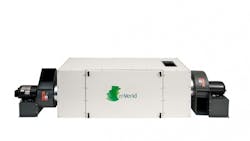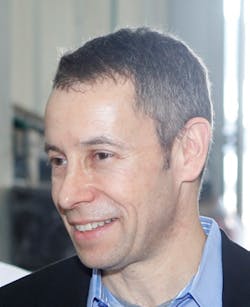Air-Filtration Technology Helps Buildings Reduce Energy Use, Costs
As he sat in a Washington, D.C., airport terminal, enVerid CEO Udi Meirav wondered how much money could be saved with a simple change.
“The air is good in this terminal because it’s going through expensive efforts to filter it from the outside,” he said. “If you can reduce the amount of air from the outside, you can save costs from filtering all of the jet fuel fumes … You’re talking millions of dollars per year with this technology.”
The technology Meirav was referring to is enVerid’s HLR (HVAC Load Reduction) system, which is designed to save energy when installed with a building’s HVAC system.
The process in most systems involves pulling in and filtering air from the outside. The problem with this, Meirav said, is that it is a tremendous waste of energy, as introducing outside air makes for a much higher heat load and more money spent.
Instead of bringing in outside air, HLR takes air that is already inside, helps clean the carbon dioxide (CO2) and organic gasses released by occupants and rids the air of indoor materials using an intelligent scrubber. This lowers heat load and improves indoor-air quality, minimizing outside air.
A Secret Weapon for Efficiency
HLR’s process is one that, Meirav admitted, is easy to describe but not easy to do. It’s especially difficult to remove CO2 from a building, as the technology simply has not been there to do this in a way that is cost-conscious.
“CO2 is hard to capture in a cost-effective way,” he said. “People have been doing it for decades, but it’s an expensive process due to energy usage and the materials used. They can do it easily in a small space like a submarine or spacecraft because they don’t worry about the cost. But doing this in a large building, you need to do things differently.”
The technology has never been used in conjunction with HVAC systems and was built in government labs and universities. This was not something that came together because of the needs of HVAC and buildings, but instead because of scientists wanting to cut down on greenhouse gases. Now, enVerid is able to leverage that technology into something that can help optimize the energy large buildings use.
The company, which is based in Houston with locations in Boston and Israel, has been endorsed by the U.S. Green Building Council and is already being implemented in many LEED-certified buildings. Popularity is starting to pick up, as, he said, more companies are convinced of the validity of the product through savings.
“Everybody likes the fact that its green, but they wouldn’t pay an extra dime for it,” Meirav said. “They can get a return on their investment with this. It costs money to install and operate, but the electric savings you get far exceed the initial money you spend. You get the ROI in a matter of two to three years. After that, you can save more and more money on energy on an ongoing basis.”
Just how much money is saved is a matter of where a building is located. For example, Meirav said if you are located in a place like Austin, Texas, where summer is long and hot, you’ll see faster returns and higher savings. Another city, such as Chicago, won’t see as drastic of savings right away, but he said there will still be dramatic cost and energy savings during cold months because of the reduction in energy used to treat outside air for heating.
“It’s absolutely new—this is a new approach to the world,” Meirav said. “It’s novel. It offers a new solution to an old problem.”
Being so new has made some wary, he said, as they want to see HLR have a longer track record before they install it in their own building. For now, early adopters are using it and having success, he said. This, in turn, is giving enVerid a fair amount of success in its first real year of marketing the product to the public.
Green: The Next Generation
How enVerid came into this technology is something Meirav called “serendipitous.”
“Myself and my co-founder [Israel Biran] were talking about how air quality is managed in buildings,” he said. “We realized there was a big problem with replacing the air with outside air. As we studied this more carefully, we saw that the main reason we have to replace air in buildings is due to internal of buildup of molecular particles.”
While other particles and molecules can be filtered, there wasn’t a finite answer for how to efficiently get rid of CO2 from a building’s atmosphere. From a technology standpoint, Meirav said there needed to be a better way to get rid of all of the CO2 from a building. He and the enVerid team looked at all of the innovations made and identified the technology used for HLR, which was being made by a government lab.
To use this technology, enVerid worked with the National Energy Technology Laboratory (NETL) and the Office of Energy Efficiency and Renewable Energy (EERE). NETL worked on the technology side, EERE is looking into how buildings are being made energy-efficient in big cities.
“[EERE] came in later and are now very strong supporters,” Meirav said. “There are multiple stakeholders here, in terms of the HLR’s benefits. The end customers pay energy bills, but utilities get a huge benefit by seeing peak demand reduced. That’s extremely valuable, so, of course, the government benefits.”
Multiple Successes, Multiple Options
So far, Meirav said the HLR has been deployed at multiple sites, and cost and energy-saving benefits are something each building has seen.
“We don’t have to compare this year to last year,” Meirav said. “We can turn it on and off and get a very precise measurement of direct impact of the HLR model, metering a few days on and a few off. We can do it with any season or any time of year. … What we’ve seen in buildings where we have installed, we’ve seen in summer a reduction of 40 percent of the load and energy consumption of the cooling system. We’ve done that in multiple locations. Forty percent is a very real energy savings for summer time.”
For the hottest days of the year, Meirav said these savings can reach as much as 50 percent, something that will certainly help cut down on peak load charges.
Size doesn’t matter when it comes to where this technology can fit, as HLR is designed to be a retrofit for buildings, something that can fit on existing equipment without any add-ons. Meirav said it can be placed on plenums, air head links, or anywhere air can be cleaned and returned to a building.
“With the air circulation of buildings, it doesn’t matter where you do this; it could be anywhere,” he said. “It grabs air, cleans it, and puts it back. However, it’s easier to put it in the mechanical room right next to air handlers or on the rooftop.”
Meirav said HLR typically is installed in office buildings of 200,000 to 1 million sq ft. Some airport terminals, as well as some larger malls, have square footage in the millions, however.
“The unit is modular,” he said. “For every approximately 10,000 sq ft in the building, we’d put in a module. For a larger building, we’d need larger modules so that we can put one or two next to each air hander. This is how we’re able to address [the needs of each individual customer]. We have more than one version of the project, but only a handful of different sizes. Usually, we stack two or three in the building we’re working on.”
Meirav is confident that while contaminants may never be completely eliminated from buildings, improvements have been made with HLR and will continue as the technology is refined.
“We’re still a small company, and it will take a while to scale this thing up,” he said. “This is just the beginning.”

